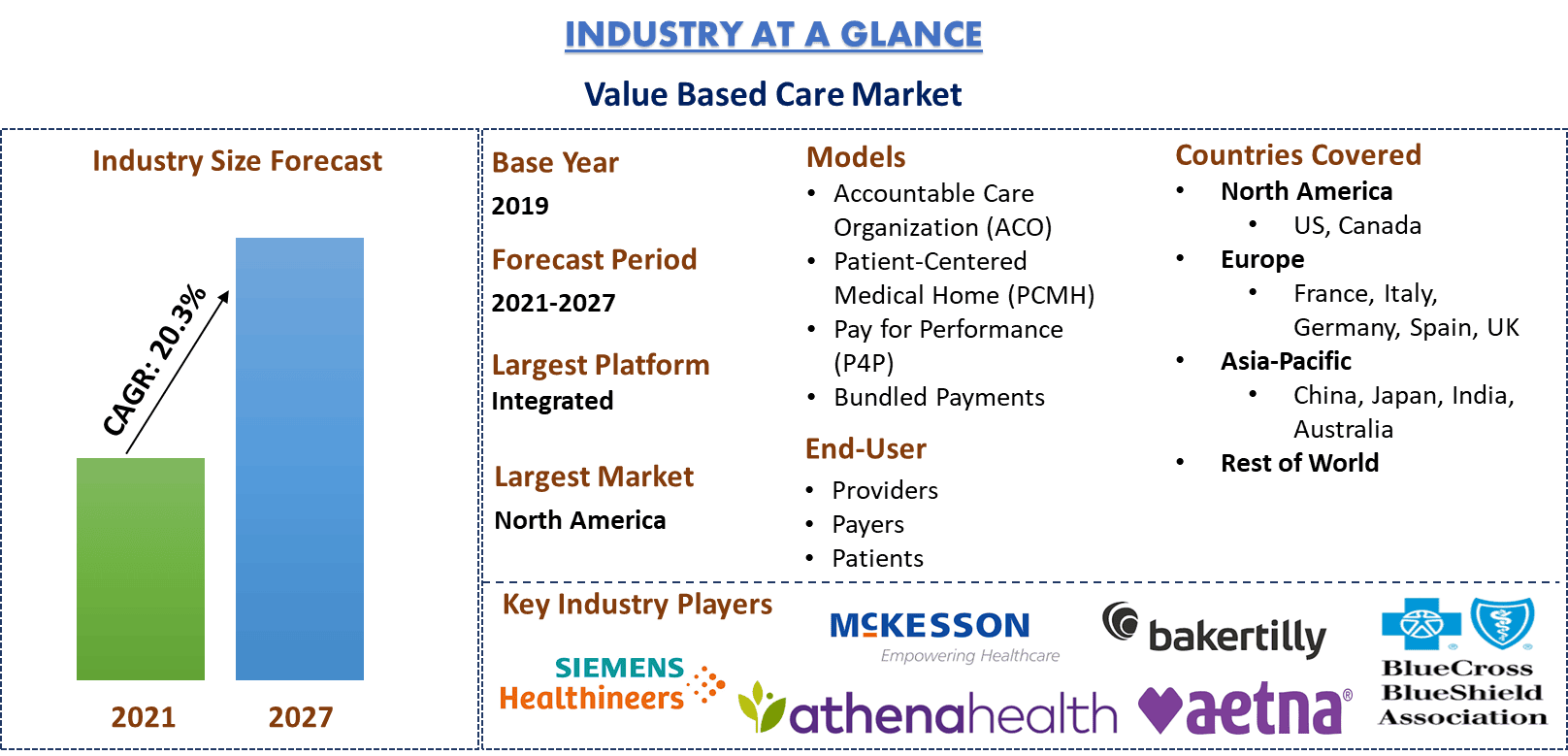- Home
- About Us
- Industry
- Services
- Reading
- Contact Us
Value-Based Care Market: Current Analysis and Forecast (2021-2027)
Emphasis on Models (Accountable Care Organization (ACO), Patient-Centered Medical Home (PCMH), Pay for Performance (P4P), Bundled Payment); Deployment Type (Cloud-Based and On-Premises); Platform (Standalone, Integrated); End-Users (Providers, Payers, Patients); and Region & Country.

Value-based care is a proactive concept of improving care for patients. With its core based on complete fitness and preventive treatments, value-based care improves healthcare outcomes and reduces costs. The goal of value-based care is to standardize healthcare processes through best practices, as in any business. Here, mining of data and evidence can determine which processes work and which don’t. This forms a foundational cloud-based “care pathway” to help patients get the best results on a virtual platform also. According to “Humana” a healthcare firm, value-based care providers like Ochsner Health, Louisiana’s largest nonprofit health system, saw activity on its virtual care network jump from 3,000 primary care visits a year to 3,000 a day. Also, patients who were seen by physicians in value-based care arrangements collectively spent 211,000 fewer days as hospital inpatients and less time obtaining care in emergency rooms in 2019 compared to those in non-value-based care models. This has increased the demand for value-based care in people as it provides better care at lesser costs. Moreover, the Department of Health & Human Services (HHS) set their target of securing 30% of payments for traditional medicare benefits to value-based payment models by the end of 2016 and 50% by 2018.
Increasing advancement in value-based healthcare services is a factor behind the tremendous growth of this market. The Healthcare cost curve and excessive health expenditure have been reduced due to value-based healthcare services. According to “UnitedHealth Group”, a US-based health insurance company, which provides value-based payments to healthcare providers has noted the progress of this industry was rising at more than 15% in 2019. It provides incentives to practice supreme quality care while enhancing the effective use of health system resources. Further, in 2018, “Cigna” acquired “Express Scripts” a pharmacy benefit management organization to brings new capabilities and resources to continue their progress towards a value-based care environment. Collaborations in value-based care are earning popularity among the providers as these collaborations allow partners such as medical device manufacturers, payers, and provider organizations to create programs, solutions, and initiatives combined for the benefit of patients and healthcare systems. For instance, in March 2018, “Optum” the health business services arm of UnitedHealth Group, and “HealthBI” announce a partnership aimed at creating an industry-changing operation model for providers to practice and improve value-based care.
Number of US states and Territories implementing VBC Programs, from 2011 to 2018
Siemens Healthineers, Nextstep Solutions, Athena Health, NXGN Management, LLC, McKesson Corporation, Optum, Oliver Wyman, Baker Tilly, Aetna and, Blue Cross Blue Shield Association are some of the prominent players operating in the global value-based care market. Several M&As along with partnerships have been undertaken by these players to facilitate customers with hi-tech and innovative products.
Insights Presented in the Report
“Amongst Models, Accountable Care Organization (ACO) segment holds the major share”
Based on models, the market is fragmented into Accountable Care Organization (ACO), Patient-Centered Medical Home (PCMH), Pay for Performance (P4P), Bundled Payment. The Accountable Care Organization (ACO) segment dominated the market in 2020 as they provide high-quality care to the Patients and managed to reduce the cost of care.
“Amongst Deployment, Cloud-Based segment is anticipated to grow at the highest CAGR during the analyzed period”
Based on deployment, the market is fragmented into cloud-based and on-premises. The cloud-based segment accounted for the major revenue portion in 2020. As, the companies such as Qualcomm Life Inc., Opzoon Technology Co., Ltd., and Fibocom Wireless Inc. are involved in the sales of wireless and cloud-based technology products used in the healthcare industry.
“Amongst Platform, Integrated segment is anticipated to grow at the highest CAGR during the analyzed period”
Based on the platform, the market is fragmented into standalone and integrated. The integrated platform segment accounted for the major revenue portion in 2020. The sector is anticipated to observe significant growth in the upcoming years as when payers and other stakeholders in integration make significant investments, they produce additional profits.
“Amongst End-User, the Providers segment holds the major share”
Based on end-user, the market is fragmented into providers, payers, and patients. The providers’ segment is anticipated to observe lucrative growth. As providers are not only concentrating on growing their infrastructure but also trying to improve it. So, that the patients can get easy access to healthcare facilities and cost reduction.
“North America signifies one of the largest markets of Value-Based Care Market”
For a better understanding of the market dynamics of the Value-Based Care market, a detailed analysis was conducted for different regions across the globe including North America (United States, Canada, and the Rest of North America), Europe (Germany, France, Italy, Spain, United Kingdom and Rest of Europe), Asia-Pacific (China, Japan, India, Australia and Rest of APAC), and the Rest of World. North America constitutes a major market for the value-based care industry and generated the maximum revenue in 2020 owing to the presence of key companies and advance healthcare infrastructure with the highest spendings on healthcare.
Reasons to buy this report:
- The study includes market sizing and forecasting analysis validated by authenticated key industry experts
- The report presents a quick review of overall industry performance at one glance
- The report covers an in-depth analysis of prominent industry peers with a primary focus on key business financials, product portfolio, expansion strategies, and recent developments
- Detailed examination of drivers, restraints, key trends, and opportunities prevailing in the industry
- The study comprehensively covers the market across different segments
- Deep dive regional level analysis of the industry
Customization Options:
Value-Based Care Market can further be customized as per the requirement or any other market segment. Besides this, UMI understands that you may have your own business needs, hence feel free to connect with us to get a report that completely suits your requirements
Table of Content
Analyzing the historical market, estimation of the current market, and forecasting the future market of the global value-based care market were the three major steps undertaken to create and analyze the adoption of value-based care across major regions globally. Exhaustive secondary research was conducted to collect the historical market numbers and estimate the current market size. Secondly, to validate these insights, numerous findings and assumptions were taken into consideration. Moreover, exhaustive primary interviews were also conducted, with industry experts across the value chain of the value-based care sector. Post assumption and validation of market numbers through primary interviews, we employed a top-down/bottom-up approach to forecast the complete market size. Thereafter, market breakdown and data triangulation methods were adopted to estimate and analyze the market size of segments and sub-segments the industry pertains to. Detailed methodology is explained below:
Analysis of Historical Market Size
Step 1: In-Depth Study of Secondary Sources:
Detailed secondary study was conducted to obtain the historical market size of the value-based care through company internal sources such as annual report & financial statements, performance presentations, press releases, etc., and external sources including journals, news & articles, government publications, competitor publications, sector reports, third-party database, and other credible publications.
Step 2: Market Segmentation:
After obtaining the historical market size of the value-based care market, we conducted a detailed secondary analysis to gather historical market insights and share for different segments for major regions. Major segments included in the report are models, deployment, platform, and end-user. Further country-level analyses were conducted to evaluate the overall adoption of value-based care in every region.
Step 3: Factor Analysis:
After acquiring the historical market size of different segments and sub-segments, we conducted a detailed factor analysis to estimate the current market size of value-based care. Further, we conducted factor analysis using dependent and independent variables such as higher patient satisfaction rates with providing better care efficiencies and reducing pressure on patients with lowering the healthcare expenditure. A thorough analysis was conducted for demand and supply-side scenarios considering top partnerships, merger and acquisition, business expansion, and among others in the value-based care industry across the globe.
Current Market Size Estimate & Forecast
Current Market Sizing: Based on actionable insights from the above 3 steps, we arrived at the current market size, key players in the value-based care market, and market shares of the segments. All the required percentage shares split, and market breakdowns were determined using the above-mentioned secondary approach and were verified through primary interviews.
Estimation & Forecasting: For market estimation and forecast, weights were assigned to different factors including drivers & trends, restraints, and opportunities available for the stakeholders. After analyzing these factors, relevant forecasting techniques i.e., the top-down/bottom-up approach was applied to arrive at the market forecast about 2027 for different segments and subsegments across the major markets globally. The research methodology adopted to estimate the market size encompasses:
- The industry’s market size, in terms of value (USD) and the adoption rate of value-based care across the major markets domestically
- All percentage shares, splits, and breakdowns of market segments and sub-segments
- Key players in the value-based care market in terms of services offered. Also, the growth strategies adopted by these players to compete in the fast-growing market
Market Size and Share Validation
Primary Research: In-depth interviews were conducted with the Key Opinion Leaders (KOLs) including Top Level Executives (CXO/VPs, Sales Head, Marketing Head, Operational Head, and Regional Head, Country Head, etc.) across major regions. Primary research findings were then summarized, and statistical analysis was performed to prove the stated hypothesis. Inputs from primary research were consolidated with secondary findings, hence turning information into actionable insights.
Split of Primary Participants in Different Regions
Market Engineering
Data triangulation technique was employed to complete the overall market estimation and to arrive at precise statistical numbers of each segment and sub-segment of the value-based care market. Data was split into several segments & sub-segments post studying various parameters and trends in the areas of models, deployment, platform, and end-user of the value-based care market.
Main Objective of the Value-Based Care Market Study
The current & future market trends of value-based care were pinpointed in the study. Investors can gain strategic insights to base their discretion for investments from the qualitative and quantitative analysis performed in the study. Current and future market trends were determined the overall attractiveness of the market at a regional level, providing a platform for the industrial participant to exploit the untapped market to benefit as a first-mover advantage. Other quantitative goals of the studies include:
- Analyze the current and forecast market size of value-based care in terms of value (USD). Also, analyze the current and forecast market size of different segments and sub-segments
- Segments in the study include areas of models, deployment, platform, and end-user
- Define and analysis of the regulatory framework for the value-based care industry
- Analyze the value chain involved with the presence of various intermediaries, along with analyzing customer and competitor behaviors of the industry
- Analyze the current and forecast market size of the value-based care market for the major region
- Major regions studied in the report include North America (the United States and Canada), Europe (Germany, France, Italy, Spain, and United Kingdom), Asia-Pacific (China, Japan, India, and Australia), and the Rest of World
- Company profiles of the value-based care market and the growth strategies adopted by the market players to sustain in the fast-growing market
- Deep dive regional level analysis of the industry
Related Reports
Customers who bought this item also bought












